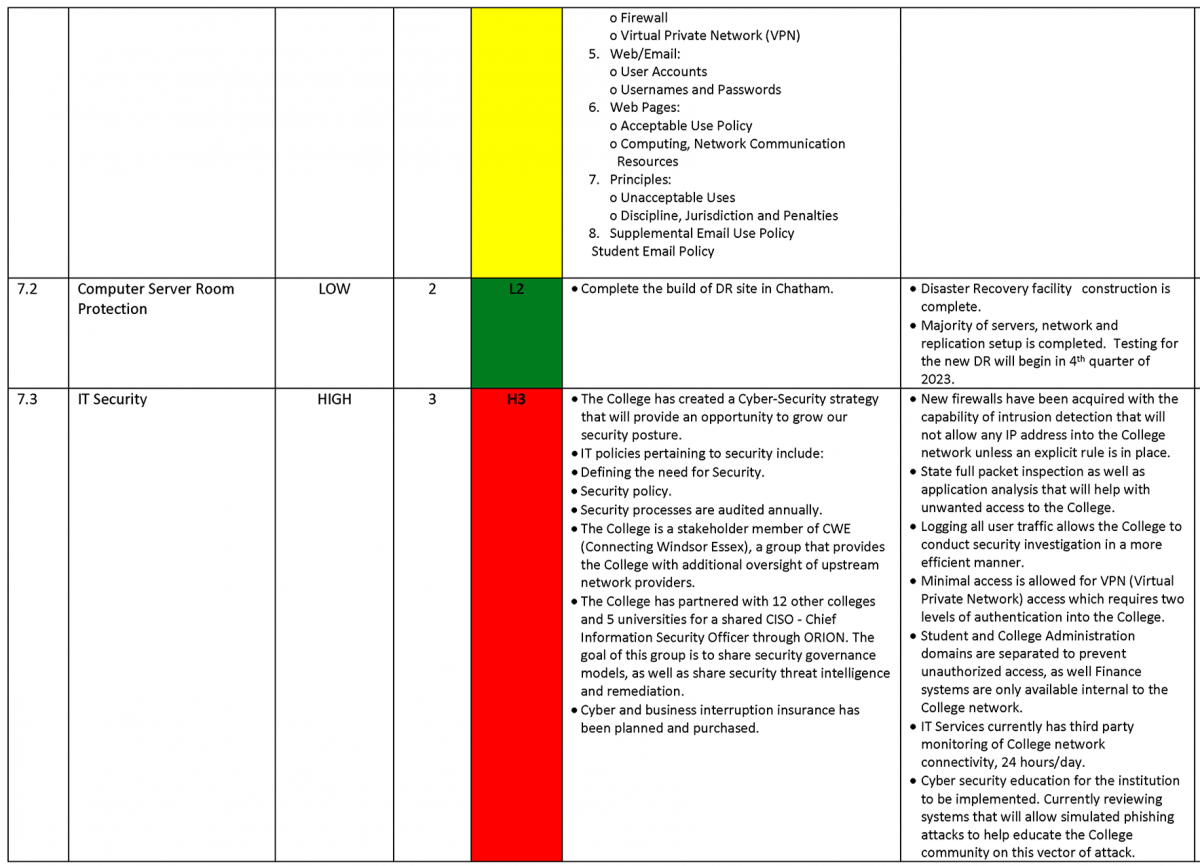
GRAPHIC ABOVE: A page sample of the Risk Management report, showing the colour-coding and numerical methods of identifying likelihood and impact.
The brightest shade of worrisome red, and the highest “number of alarm”, popped up in an obvious spot on this year’s Risk Management report, presented to the Board of Governors by the college’s administration during its February 27th meeting: achieving enrolment projections.
Obtaining domestic (Canadian) enrolment growth has been a challenge for decades, due simply to the low birth-rate in the college’s base-communities of Windsor-Essex and Chatham-Kent – and, indeed, throughout much of Ontario and Canada.
When domestic enrolment jumped by two percent in this academic year (2023-24), that was the first increase of that sort that had been witnessed in years. Customarily, it has been stagnant at best, or in slight decline at worst. So, the task of “Meeting Domestic Enrolment Targets” has always been shaded in red in the colour-coded “probability scale” of the Risk Management report.
Red means there is a high probability that the goal could be missed, because the failure to achieve it has happened frequently in the past and/or has a significant chance of happening in the future. The other colours of the probability scale are amber, meaning that there is a reasonable chance of a goal being achieved or a fair chance of an incident occurring; and green for great certainty that a goal will be achieved or that no problems will arise.
The domestic enrolment category also had the number 3 attached to it in the Risk Management report. The numbers define the impact of the fate of goal-setting or incident-occurrence. In this case, it means that the failure to meet domestic enrolment targets would have a high/dire impact on the college’s operation. (The number 2 would mean a medium level of impact, 1 would mean that no service disruptions or substantial negative effects would occur, and 0 means that any risk is not really relevant.)
Joining domestic enrolment in the “Red/3” category is the task of “Meeting International Student Recruitment Targets”.
The federal and provincial governments recently implemented a two-years-long “pause” on international student immigration – limiting the number of global students coming to public colleges, and removing post-graduate work permits for students attending public/private-partnered schools (such as St. Clair’s “sister school” in Toronto, the Ace Acumen Academy). That means that there is a very great probability that St. Clair’s (incoming) international enrolment will decline severely, and that the effect on the school’s revenue will be dire ... at least for the next few years of the government-ordered “pause”.
For that reason, too, several sections of the financial section of the Risk Management report are also labelled in red this year, indicating concern that revenues will certainly be threatened by the reduction of international enrolment at the Windsor and Chatham campuses, and that the partnership with Ace Acumen might be severely jeopardized.
While the college can sustain itself for a couple of years with the substantial financial surpluses (set aside as “rainy day funds” in reserves) that it has generated during the past half-dozen years, it must hope that the government-ordered “pause” will prove to be just that – and that international student immigration is eventually allowed to resume.
The other red-hued sections of the annual report, as they have been historically, are: “Emergency” (such as an active shooter on campus) and “Information Technology Security” (that is, a major computer hack and/or ransomware attack on the college).
The attack shooter (etc.) scenario would be a dire situation, but it is labelled as only a “medium” risk (because it has never happened). Among the many preparatory, preventative and cautionary measures that the college has implemented to mitigate that risk is this past year’s newly implemented requirement for all students to take a mandatory on-line course in “what to do in case of an emergency”.
Threats to the I.T. system, meanwhile, are viewed as both dire impact and high possibility, because so many other schools, public agencies and private companies have suffered computer attacks. Working with both in-house personnel, private consultants and a consortium of 17 postsecondary institutions, the college’s I.T. Department has implemented dozens of policies, procedures and protection systems to limit damage to and attacks on the school’s computers and networks.
Presenting the report to the Board was Ralph Nicoletti, the Executive Director of the President’s Office and Corporate Secretary.
He noted that, as usual, eight broad sectors of the college are regularly reviewed for potential risk: Academic and Student Services, Facilities Management, Finance, Human Resources, Health and Safety, Health Services, Information Technology, and Corporate.
The process is “upward flowing”, he added. Front-line staff are in the best position to identify risk-laden situations as they arise, which are then reported to the managerial level, then to a Risk Management Committee that meets monthly to review submissions and develop mitigation strategies, then to the Senior Operating Group (top-level administration) for its review and input. Finally, the Board of Governors is advised of risk as needed – either immediately, when dire situations arise; or, at the very least, during the annual report’s tabling.
Nicoletti did add that – on the bright side – the risky nature of operating the college had been reduced somewhat in the past year. In 2022-23, the report had 11 items in the worrisome “red” category, reduced to a half-dozen this year. Mitigation strategies and solutions that were implemented thanks to boosted funding by the Board were able to ease/eliminate many looming threats to various college operations in the past year.
OTHER STORIES FROM THE BOARD OF GOVERNORS MEETING
• BUILDING PROJECT UPDATE: https://news.stclair-src.org/need-know-news/board-updated-about-progress-building-projects
• CAREER SERVICES BUSY DURING THE PAST YEAR: https://news.stclair-src.org/need-know-news/board-learns-about-careers-offices-activities
• STILL ON-TRACK FOR YEAR-END BUDGET SURPLUS: https://news.stclair-src.org/need-know-news/college-still-track-hefty-surplus
• CAMPUS GETS MORE BEAUTIFUL EVERY YEAR: https://news.stclair-src.org/need-know-news/beauty-eye-campus-beholder-0
• SAINTS BEING SAINTS THROUGHOUT THE COMMUNITY: https://news.stclair-src.org/need-know-news/saints-busy-throughout-community
• COLLEGE EXCEEDING ON-LINE CURRICULUM GOAL: https://news.stclair-src.org/need-know-news/college-way-ahead-its-line-curriculum-goal
• ALMOST 100 STUDENTS NOW INVOLVED IN R&I: https://news.stclair-src.org/need-know-news/almost-100-students-now-involved-ri-projects







